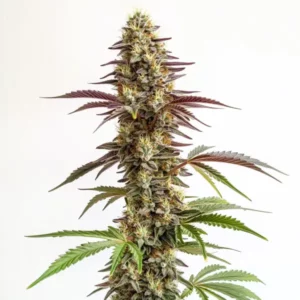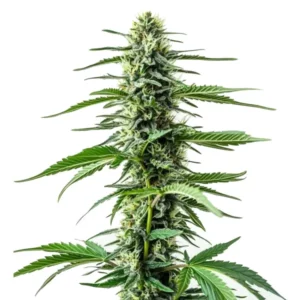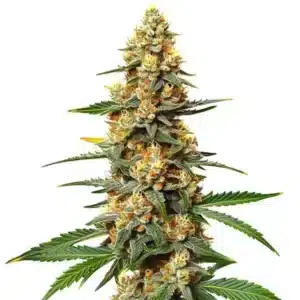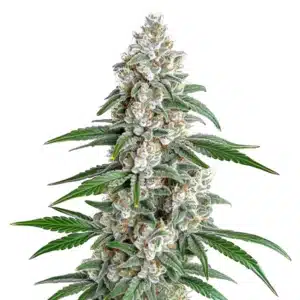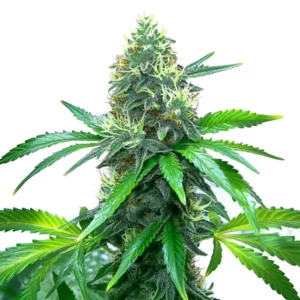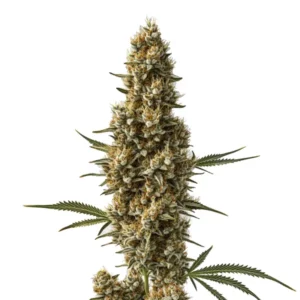
Enzyme Role in Cannabinoid Formation
When diving into the world of cannabis cultivation, knowing the enzyme role in cannabinoid formation can elevate your growing game. Cannabinoids are the compounds that give cannabis its unique effects and benefits. But what makes these compounds tick? The secret lies in the enzymes. Think of enzymes as the workers that build cannabinoids from scratch.
Enzymes are biological catalysts. They speed up chemical reactions without getting consumed. In cannabis, they play a crucial role in transforming basic compounds into cannabinoids. This is the essence of enzyme-mediated cannabinoid production. Without these enzymes, the magic of cannabis wouldn’t be possible.
Recommended Strains
Asian Dream
|
|
THC | 17% - 22% (Medium) |
|
|
Type | Feminized |
|
|
Yield | High |
|
|
Phenotype | 60% Indica / 40% Sativa |
Blue Cookies
|
|
THC | 18% - 21% (Medium) |
|
|
Type | Feminized |
|
|
Yield | Medium |
|
|
Phenotype | 90% Indica / 10% Sativa |
Take the example of the strain GSCxChemdawg from Blimburn Seeds. Known for its potent effects, its unique cannabinoid profile is a result of specific enzymes doing their job. Each strain has a different set of enzymes at play, leading to varied effects and benefits.
Enzyme Involvement in Cannabinoid Biosynthesis
The process of cannabinoid formation begins with the basic building blocks. These are simple organic compounds found within the cannabis plant. Enzymes come into play by converting these compounds into cannabinoids through a series of steps. This intricate dance is known as cannabinoid biosynthesis.
Without enzyme involvement in cannabinoid biosynthesis, the plant wouldn’t produce THC, CBD, or other cannabinoids. Enzymes like THCA synthase and CBDA synthase are specifically responsible for creating THC and CBD. They ensure that each molecule is correctly formed, resulting in the cannabis effects we know and love.
The enzyme role in cannabinoid formation is not just limited to major cannabinoids like THC and CBD. Minor cannabinoids such as CBG and CBC also owe their existence to specific enzymes. These enzymes are essential for diversifying the chemical makeup of cannabis, allowing for a broad spectrum of uses and effects.
In the broader picture, enzyme involvement in cannabinoid biosynthesis contributes to the adaptability of cannabis plants. Different strains can be optimized to produce specific cannabinoids in response to environmental cues, driven by the underlying enzymatic machinery. This flexibility is a testament to the importance of knowing enzymes in the context of cannabis cultivation.
Key Enzymes Responsible for Cannabinoid Formation
One cannot discuss enzymes responsible for cannabinoid formation without mentioning THCA synthase. This enzyme is pivotal in creating tetrahydrocannabinolic acid (THCA), the precursor to THC. When THCA is exposed to heat, it transforms into THC, the compound that many seek for its psychoactive effects.
Another key enzyme is CBDA synthase. This enzyme helps in forming cannabidiolic acid (CBDA), the precursor to CBD. Much like THCA, CBDA turns into CBD when heated. This transformation is crucial for those looking to harness the therapeutic benefits of CBD.
The function of enzymes in cannabinoid pathways is underscored by their specificity and efficiency. Each enzyme is tailored to act on a specific substrate, ensuring that the biosynthesis process is both accurate and rapid. This precision is what allows cannabis to produce the exact cannabinoids needed for its survival and reproduction.
Furthermore, enzymes responsible for cannabinoid formation often work in concert, forming a tightly regulated network. This network can be influenced by various factors, including genetic makeup and environmental conditions, highlighting the importance of knowing enzyme function in cannabis compound synthesis.
Promos & Deals
Role of Enzymes in Cannabinoid Pathways
Each enzyme in the cannabis plant has a specific role. These roles are part of larger pathways that guide the formation of cannabinoids. The pathways are like roadmaps, directing where and how cannabinoids should be formed. Enzymes are the vehicles navigating these roads.
In the cannabinoid pathways, enzymes work in a sequence. One enzyme’s product becomes the starting point for the next enzyme. This chain reaction is essential for the diverse range of cannabinoids found in different cannabis strains. For instance, the strain Blue Dream showcases a balanced mix of cannabinoids, thanks to the seamless function of its enzymes along these pathways.
The function of enzymes in cannabinoid pathways is akin to a relay race, where each enzyme passes the baton to the next. This coordinated effort ensures that the end products, the cannabinoids, are synthesized efficiently and effectively. The enzyme role in cannabinoid formation is critical for maintaining the chemical integrity of these compounds.
Enzyme-mediated cannabinoid production is not a static process; it can be influenced by changes in the plant’s environment. Stress factors, such as nutrient deficiencies or pest attacks, can alter enzyme activity, leading to variations in cannabinoid profiles. Knowing these dynamics is crucial for growers aiming to produce consistent and high-quality cannabis.

Practical Insights into Enzyme-Mediated Cannabinoid Production
For growers, knowing enzyme-mediated cannabinoid production can influence cultivation techniques. Temperature and light exposure are two factors that can affect enzyme activity. By optimizing these conditions, growers can enhance the cannabinoid profiles of their plants.
Real-life examples show that strains grown in optimal environments tend to have higher cannabinoid content. Monitoring these conditions can lead to a more potent and effective harvest. Enzyme function in cannabis compound synthesis is something every grower should leverage.
The enzyme role in cannabinoid formation is a critical consideration for both novice and experienced cultivators. By tailoring growing conditions to favor specific enzyme activities, growers can fine-tune the cannabinoid output of their plants, aligning with consumer preferences and market demands.
Moreover, knowing enzyme involvement in cannabinoid biosynthesis can lead to innovative cultivation strategies. Techniques such as selective breeding and genetic modification could be employed to enhance specific enzyme functions, paving the way for new and improved cannabis strains with unique cannabinoid profiles.
Frequently Asked Questions (FAQs)
What are the main enzymes involved in cannabinoid formation?
Two of the main enzymes are THCA synthase and CBDA synthase. THCA synthase is responsible for synthesizing THCA, which converts to THC when heated. CBDA synthase works similarly, producing CBDA that becomes CBD upon heating. These enzymes are fundamental in shaping the cannabinoid profile of the cannabis plant.
Other enzymes also play roles in creating minor cannabinoids like CBG and CBC. Knowing these enzymes helps growers manipulate and enhance the cannabinoid content of their plants. Each enzyme has a specific function, contributing to the vast array of effects and benefits cannabis offers.
Enzymes responsible for cannabinoid formation are not just limited to the major players like THCA synthase and CBDA synthase. Enzymes such as CBGA synthase and CBC synthase also contribute significantly to the diversity of cannabinoids found in cannabis plants. Their role is essential in crafting the nuanced effects that different strains provide.
The enzyme role in cannabinoid formation extends beyond mere production; it also encompasses regulation. Enzymes can be upregulated or downregulated in response to environmental stimuli, influencing the overall cannabinoid profile. This adaptability is what makes enzyme-driven biosynthesis a fascinating aspect of cannabis biology.
How can growers influence enzyme activity in cannabis plants?
Growers can influence enzyme activity by controlling environmental factors such as temperature and light. Enzymes have optimal conditions under which they perform best. By maintaining these conditions, growers can maximize the efficiency of cannabinoid production.
For example, warmer temperatures may enhance THCA synthase activity, leading to higher THC levels. Conversely, cooler conditions might favor CBDA synthase, resulting in more CBD. Tailoring these factors according to the desired cannabinoid outcome can significantly impact the final product.
Enzyme-mediated cannabinoid production is a delicate balance that can be tipped in favor of desired outcomes through precise environmental controls. Growers who master this art can produce cannabis with specific cannabinoid concentrations, catering to diverse consumer needs and enhancing market value.
Additionally, the function of enzymes in cannabinoid pathways can be influenced by adjusting nutrient availability. Specific nutrients can act as cofactors, enhancing enzyme activity and efficiency. By knowing these relationships, growers can create optimal growing conditions that promote the desired enzymatic reactions.
Why is enzyme function important in cannabis compound synthesis?
Enzyme function in cannabis compound synthesis is crucial because it determines the types and amounts of cannabinoids produced. Without enzymes, the biosynthesis pathways would be inefficient, leading to lower cannabinoid yields. Enzymes ensure that each step in the pathway is executed smoothly.
This smooth execution is vital for producing high-quality cannabis strains. By knowing enzyme function, growers can better predict and enhance the cannabinoid profiles of their plants, leading to more consistent and potent products.
The enzyme role in cannabinoid formation is foundational to the success of cannabis cultivation. Enzymes act as gatekeepers, regulating the flow of chemical reactions that lead to cannabinoid production. Their precise function ensures that the plant’s energy resources are used efficiently, maximizing yield and potency.
Moreover, enzyme function in cannabis compound synthesis is a key factor in the plant’s ability to adapt to changing conditions. By facilitating rapid chemical transformations, enzymes allow cannabis plants to respond to environmental challenges, ensuring survival and continued growth.
Are certain strains better suited for specific enzyme activities?
Yes, certain strains have genetic predispositions that favor specific enzyme activities. For instance, strains like Blue Dream and Blackberry Kush have unique enzyme profiles that make them ideal for producing balanced cannabinoid mixes. Choosing the right strain can align with the desired effects and benefits.
Knowing the enzyme role in cannabinoid formation for each strain can help growers select the best one for their needs. This choice is crucial for achieving the intended results, whether for recreational or therapeutic purposes.
Genetic diversity among cannabis strains leads to variations in enzyme activity, which in turn affects cannabinoid production. Some strains are naturally inclined to produce higher concentrations of certain cannabinoids due to their enzymatic profiles, making them better suited for particular uses or markets.
The enzyme involvement in cannabinoid biosynthesis is a driving force behind the development of specialized strains. By leveraging this knowledge, breeders can create new hybrids with optimized enzyme functions, tailored to produce specific cannabinoid blends that meet consumer demands.
Can enzyme activity vary between different cannabis plants?
Enzyme activity can vary significantly between different cannabis plants. Factors such as genetics, environmental conditions, and cultivation practices all influence enzyme efficiency. These variations lead to diverse cannabinoid profiles even among plants of the same strain.
Growers can take advantage of these variations by optimizing growing conditions to favor certain enzyme activities. Tailoring the environment to the plant’s needs can enhance desired cannabinoid production, offering a more tailored cannabis experience.
The enzyme role in cannabinoid formation is a dynamic process, influenced by both intrinsic and extrinsic factors. Variations in enzyme activity can result in unique chemical signatures for each plant, contributing to the rich diversity found within cannabis species.
Knowing the function of enzymes in cannabinoid pathways allows growers to harness this variability, selecting for traits that enhance desired outcomes. By fine-tuning environmental conditions and selecting for genetic traits, cultivators can maximize the potential of each plant, producing cannabis with targeted effects and benefits.



